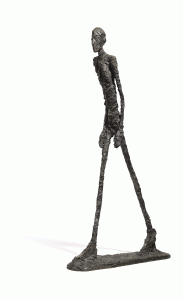« Editor's Picks, Uncategorized
Art Market Crisis ?

Alberto Giacometti (1901-1966), L’ homme qui marche I. Property formerly in the collection of Dresdner Bank AG was sold at Sotheby’s in 65,001,250 GBP. Photo courtesy of Sotheby’s.
By Elisa Hernando
The growth of the art market during the last hundred years is unprecedented in the history of art. Nevertheless, this increase is not a general trend. How can a recession affect art prices? Does a crash in the stock market influence auctions, galleries and art fairs? This article reflects on the relationship between art and the economy.
If early twentieth century artists barely survived with the support of collectors and patrons, a century later the art market is taking place on an international level with a turnover in 2008 of 928.0 million euros at auctions (source: Artprice). Growth, however, has not been linear; it has been affected by disruptions in the economy and various factors, such as, financial, legal, fiscal, cultural and social.
The twentieth century is littered with economic milestones that marked the evolution of the art market. For example, the Great Depression of 1929 affected sales and prices of works of art; a decrease is reflected in auction house records. The total number of lots sold declined and Sotheby’s, which had been selling an average of 100-150 lots before the crisis, was now auctioning off 10 to 25 lots.
The fifties were characterized by market growth. These were years of euphoria and sales of large private collections at auctions and galleries; some works, such as the Girardin collection in 1953 or the Thomson collection in 1957, achieved maximum prices. Between the years 1966-1973 the market expanded again. Surrealist artists like Max Ernst, Joan Miro, and expressionists, such as Munch, increased the price of their works; however, the oil crisis of 1973 also had an effect on the art market. In 1974 Art Basel, the world’s first contemporary art fair which was created in 1969, recorded its first ever decline in the number of visitors and sales volume.
The years ranging from the late nineteen eighties to the nineties represented the great art boom. A favorable macroeconomic scenario encouraged new collectors to buy works of art. This generated increased demand and the prices of works by Impressionist artists reached figures hitherto unthinkable. For example, the Portrait of Doctor Gachet by Vincent Van Gogh was bought at auction for $82.5 million in 1990 ($135.0 million adjusted to 2009’s inflation), while when the artist was alive, he only sold one painting (Red Vineyard). During the period 1982-1990, Artprice indicators recorded 600% increases in the prices of art works.
During the First Gulf War, the lack of liquidity of major financial markets combined with the bankruptcy of financial institutions and the economic climate of recession affected the art market and its prices shrank by 55% between 1990-1993 (source: Artprice).
A recovery of the art market could not be envisioned until the late nineteen nineties. During this period, Pablo Picasso was the star with paintings like Le rêve, whose owners, the Ganzes, paid the sum of $7,000 for it in 1941 and then sold it in 1997 at Christie’s auction house for $49.0 million. Not only did auction figures increase, but the opening of new galleries reflected the growth of interest in contemporary art, although the total amount sold was never published. Parallel to an increase in the number of galleries, new art fairs started to gain prominent status at the beginning of the twenty-first century; Art Basel Miami Beach and Frieze Art Fair are the most notable examples.
According to Artprice, prices in the United States between 2005-2008 grew by 67% and the Mei Moses Art Index reports that the annual average return was around 10% in these years. The piece by Gustav Klimt Adele Bloch, for example, was privately sold for $135.0 million in 2006. Interest in contemporary art is led by the advent of new art fairs around the world, such as, CIRCA Puerto Rico, Art Dubai, Art Shanghai. Collectors embark upon an annual pilgrimage, visiting one art fair after another.
Despite the upward trend in recent years, since 2008 the market has been characterized by a deep recession resulting from the international financial crisis. The overall Artprice price index has shown a severe correction in prices of -30%. One of the main indicators of market trend, Artprice’s AMCI (art market confidence index), also reflected the lowest level, a -26.6% decrease. Likewise, the total value of sales at art auction amounted to $8.3 billion, one billion less than the previous year’s result. In the primary market, galleries and art fairs recorded a decline in the number of visitors and sales volume.
The year 2009 continued the previous year’s trend with the Artprice index showing a contraction of 10% and prices in the international art market shrinking to 2005 levels. The recovery in art prices has been accelerating in 2010 with the record-breaking sales of Giacometti’s L’homme qui marche for $103.78 million at Sotheby’s, and Picasso’s Nude, Green Leaves and Bust, for $106.4 million at Christie’s. Collectors’ confidence in the market’s recovery reflects a degree of optimism; we shall see in the upcoming months.
Elisa Hernando is an economist and art historian. She has worked at Citibank, The Bank of New York, Galería Elba Benítez and Galería Fernando Pradilla. She is founder and director of Arte Global, a cultural management and art consulting company. Hernando currently teaches at the Universidad Antonio Nebrija, Instituto de Empresa, and Universidad Autónoma de Madrid.


































